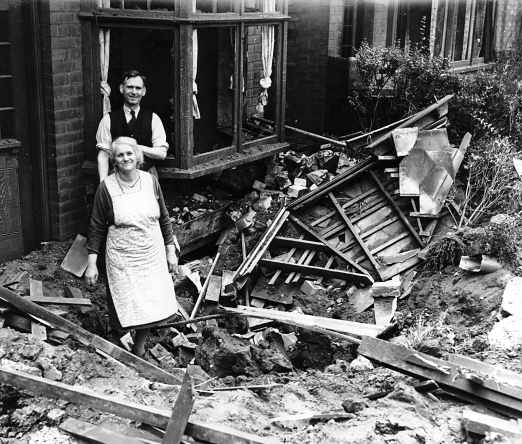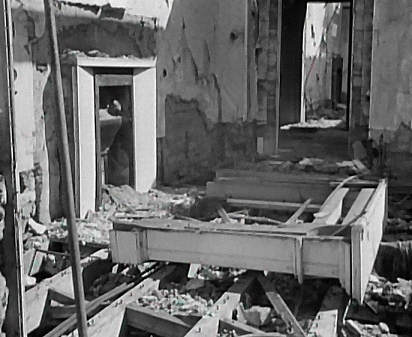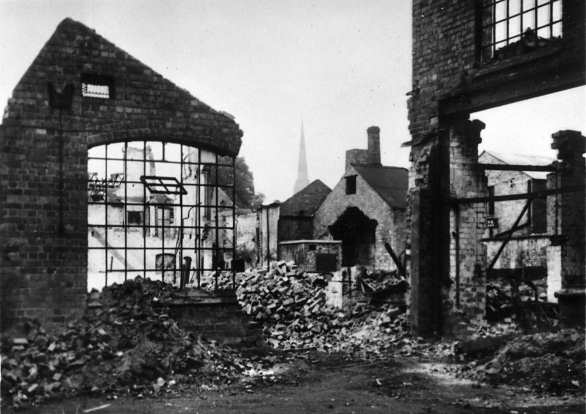|
Index...
|
 t 6:16 am Coventry was sent the 'Raiders Passed' signal. However, due to the damaged electricity supply, the most of the 'All Clear' sirens did not sound, and many people had to be told by passing Police and Air Raid Wardens that this raid was over. Gradually, as people came out from their shelters below the ground, they began to realise that virtually everything they once recognised was now gone.
t 6:16 am Coventry was sent the 'Raiders Passed' signal. However, due to the damaged electricity supply, the most of the 'All Clear' sirens did not sound, and many people had to be told by passing Police and Air Raid Wardens that this raid was over. Gradually, as people came out from their shelters below the ground, they began to realise that virtually everything they once recognised was now gone.

Many reports at the time, and since, have spoken about the heroism of the people of Coventry, and how well they bore this terrifying ordeal. In the weeks that followed, this was certainly true, but that very next day the eye witness accounts suggest a very different story. Many people wondered around, either totally bewildered by the destruction of their home town, or simply trying to find their bearings and recognise a street, or just a single building, so they could work out where to go. So many lost their homes, and of course, their loved ones, that it was all too much for them, and sheer panic set in; people crying, screaming or frantically searching for someone they knew, not knowing whether they had perished under a collapsed structure, or simply separated from them during the chaos of the raid and eventually to appear from another shelter. And who could expect anything different? There was no precedent for this - no rules for how to behave in such horrendous circumstances!

The sights and scenes that day can only be imagined by the younger generations, but must have lived in the memories of many for a lifetime. Even nowadays, we often meet folk who lived through the wartime bombing, and despite the passing of time, still "don't like to talk about it". Not too surprising in hindsight, for the streets on the 15th November were not only filled with rubble, but also strewn with corpses and body parts - not a sight that anyone, let alone a child, should ever have to set eyes upon.
With the town centre of Coventry being relatively small, and the bombing so concentrated, the initial feeling of many people that morning was that "Coventry is finished", and they simply wanted to leave - to get away from it all. The whole event was just too shocking for anyone to take a calm, objective view, and they wondered around feeling helpless. So many places of work were flattened too, and without being able to contribute towards the war effort, there temporarily seemed to be no sense of direction in their lives.
Everyone, whatever their position, was deeply affected by the raid. The loss of so many fine historic buildings was too much for Coventry historian, Frederick Smith, who was also the Town Clerk. He was found in tears by a reporter who went to meet him at the Council House that Friday. (Fred Smith would later write a detailed history of our city in a book called "Coventry - 600 Years of Municipal Life".)
 o assist in both clearing up the mess and keeping some semblance of order, hundreds of police and soldiers were brought into Coventry that next day. Initially 600 soldiers arrived, later hundreds more, including many Royal Engineers to help with the safe demolition of the numerous precariously balanced buildings.
o assist in both clearing up the mess and keeping some semblance of order, hundreds of police and soldiers were brought into Coventry that next day. Initially 600 soldiers arrived, later hundreds more, including many Royal Engineers to help with the safe demolition of the numerous precariously balanced buildings.
The most dangerous job though, was undoubtedly the neutralising of unexploded or delayed action bombs, for which the Navy's bomb disposal team was brought in. These devices were purposely dropped by the Germans to disrupt the clearance - and that, they certainly did! More casualties were added to the total the next day from the unexpected blast of hidden bombs, and rather than being able to get on with things, life came to a standstill for some, as they waited for cordoned off areas to be made safe. It was recorded that 211 of these fiendish devices had to be dealt with altogether.

As the day wore on, the authorities attempted to piece things together. The council, led by Mayor John Moseley, (known by all as 'Jack') and government department, the Ministry of Information, tried to organise and give advice, and mobile canteens were set up by the WVS (Women's Voluntary Service) to feed the thousands of citizens who had both nothing to eat.... and nowhere to cook!
The problems that started to come to light in Coventry that day are almost too numerous to mention, but amongst the most severe issues were the lack of, in virtually the whole of the city, water, electricity and gas mains supplies. Although lack of power was obviously an inconvenience, the lack of mains water was by far the most serious, and the biggest concern was an outbreak of typhoid through lack of hygiene and contaminated water obtained from broken pipes. Initially large tankers of any kind had to be used to bring in water from outside - the largest available being a large Co-operative Creamery milk tanker! Typhoid was still a real risk, however, and over the following few days about 30,000 anti-typhoid inoculations were carried out by dedicated medical staff.
But, as the people of Coventry had always done throughout history, slowly but surely they rallied and bounced back into action. There was a job to be done, and once the shock had worn off, it was time to get back on with it. Nobody was yet aware, but the next day something would happen that would raise morale quicker than anyone could have expected....
Clicking the image will reveal the extent of the damage as viewed the next day from the spire of the adjacent Holy Trinity church.
(Wartime photo taken from the November 29th 1940 issue of The War Illustrated.)
Website by Rob Orland © 2002 to 2026